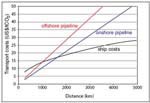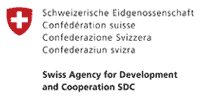Piégeage et stockage du CO2
Seule la version anglaise a reçu l'approbation du Comité Scientifique de GreenFacts.
Plus d'info sur notre structure à 3 niveaux
4. How can CO2 be transported once it is captured?
- 4.1 What are the methods of CO2 transport?
- 4.2 How expensive is CO2 transport?
4.1 What are the methods of CO2 transport?
Except when the source is located directly over the storage site, the CO2 needs to be transported to the storage site. There are several ways of doing this.
Concentrated streams of CO2 can safely be transported through pipelines at high pressure. Such pipelines have been used in the USA since the early 1970s for enhanced oil recovery (EOR) and are currently the main method for transporting CO2. Experience over the past decades, mainly with gas pipelines, has shown that very few accidents occur and that risks associated with appropriately designed pipelines are low.
CO2 can also be transported as a liquid, in ships similar to those transporting liquefied petroleum gas (LPG).
In liquid form, CO2 could technically also be transported on road tankers or railcars in insulated tanks at low temperature and at much lower pressure than in pipelines, but this option is not economical for large scale CO2 transport. More...
4.2 How expensive is CO2 transport?
For both pipeline and marine transportation of CO2, costs depend on the distance and the quantity transported. For pipelines costs are higher when they are routed offshore or across heavily congested areas, mountains or rivers. Fluctuations in the price of steel would also have an impact on the cost of pipeline transport. For a distance of 250 km (about 155 miles), the estimated cost of pipeline transport typically ranges from 1-8 US$ per tonne CO2.
In ship transport, costs depend on characteristics such as
tanker volume. If transport by ship is possible, it is generally
cheaper than pipeline transport for distances over 1000 km and
for amounts of CO2 smaller than a few million tonnes
per year (see Figure TS.6![]()
Partenaire ayant collaboré à cette publication
Les niveaux 1 et 2 de ce dossier sont des résumés du rapport écrits par GreenFacts avec le soutien financier de la Direction du développement et de la coopération suisse (DDC).




